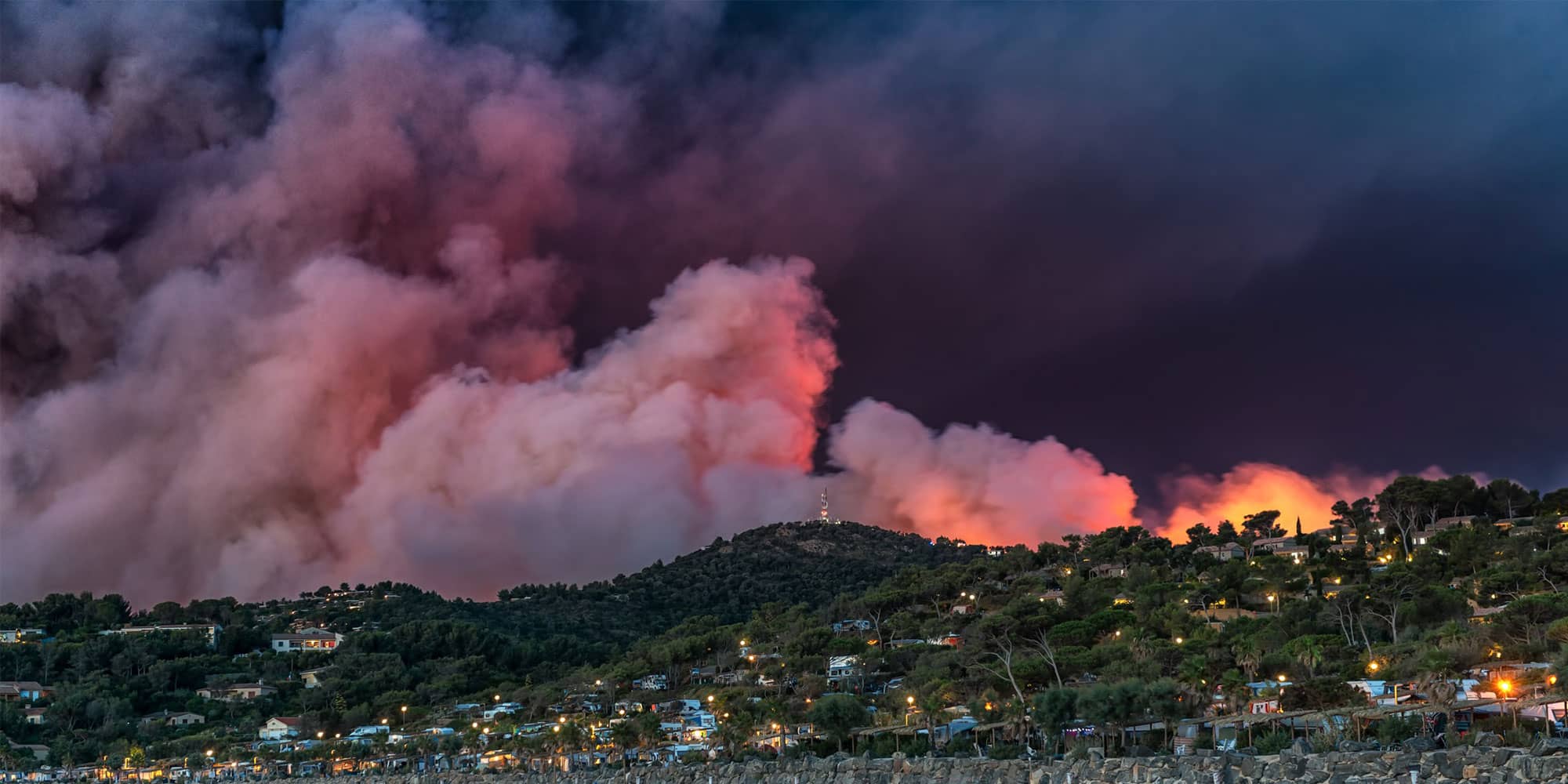Property owners have an advantage over wildfires, more so than any other natural catastrophe.
Unplanned fires that burn in natural areas like forests, grasslands or prairies, wildfires can quickly spread and devastate anything in their path. They ignite only when distinct combinations of elements exist: heat, oxygen and fuel. If you remove elements that fuel a fire from around your property, you reduce its ability to spread — greatly reducing your risk.

Develop a plan
Staying current of wildfire season developments can help enhance your ongoing planning and preparedness. Technology can also support your wildland fire planning and response. You can download a smart phone app to track real-time activity of wildfires in your area. You can also make sure that you receive emergency alerts that help keep you better informed.
Emergency planning
- You will, in all likelihood, need to rely on yourself in the event of a disaster. Local emergency services will be focusing on the larger picture and may not be able to offer much, if any assistance at all. Having an emergency plan beforehand is critical to keeping your facilities, your employees and you safe.
- During wildfire season, you may be forced to evacuate your business. Don’t wait until you see smoke or fire to make a decision to evacuate and determine your evacuation routes. People are your first priority. Most fire evacuations provide at least a three-hour notice. Take proactive steps to make sure that everyone in your organization knows and understands what to do before and during an evacuation (where you may have to evacuate quickly) to reduce anxiety and avoid injuries.
Business continuity plan
A business continuity plan, which should be part of your crisis management plan, can help manage losses more effectively and reduce potential downtime to your business.
Document your property and structures
- Keep a current inventory of your business property in the event a building becomes damaged.
- Consider taking pictures or a video and store in a secure, password-protected digital space.
FEMA has prepared a “Playbook” on how you can “Protect Your Property From Wildfires” that provides valuable information on how to mitigate many of your risks.
Controlling wildfire exposures
Protecting your structures from ignition and fire damage is an important program objective second only to an evacuation plan. Taking precautions ahead of time can help reduce the exposure of a wildfire intrusion. There are a number of proactive measures a business can take to mitigate property damage.
Create defensible space
To reduce the opportunity for wildfire to ignite your business, maintain 3 defensible zones around your buildings.
Reduce vegetative fuel
- To reduce ignition sources create a vegetation maintenance plan using plants with low combustibility characteristics such as high moisture content, low oil or resin content, deep roots with thick heavy leaves and a minimal production of dead vegetation. Thin, prune, and rake your property of crackling dry debris regularly so it stays fire resistant.
- There's no such thing as a fire proof plant—any plant will burn if the flames are hot enough, and wildfires can reach 900°. Some plants can slow a fire if they are watered and pruned regularly.
- Visit a fire wise garden near you (or their informative websites), to learn more about protecting your structure from wildfires.
- Cut back any tree branches overhanging your roof to within 15 to 20 feet of the property, and keep shrubs growing next to the structure at under 1 1/2 feet tall.
- Regularly remove debris from roof and gutters, since it can be ignited by wind-blown embers.
- In heavily wooded areas, cut down any weak or diseased trees, and eliminate fire “ladders”—plants of different heights that form a continuous fuel supply from the ground up into the tree canopy.
Fire hydrants
Confirm that fire hydrants are located in close proximity to your primary buildings (250 feet or less) and are connected to a reliable public or private water source.
Prep the structure
- Select roof covers with a Class A fire rating.
- Choose gutters and downspouts made of noncombustible materials such as aluminum. The gutter should incorporate an integral metal flashing at the roof edge, or a separate flashing should be used at the roof edge.
- Eliminate eaves or enclose them with stucco or other nonflammable material.
- To protect against embers entering your building, install 1/8-inch noncombustible wire mesh screening over all vents. When fire approaches, block the vents with precut plywood.
- Use non-flammable masonry or wrought iron for fences, railings, and walls that adjoin the house.
- Enclose decks in wild land areas with skirts of concrete, stucco, or other non-flammable materials. Or, use oversize timbers (6-by-6 inch posts and beams) to build them.
- Select windows that are dual-paned with tempered glass to reduce heat transfer through the glass. For operational windows, install screens to cover sections that can open. Always close windows when wildfire threatens.
The Insurance Institute for Business & Home Safety have prepared a useful Business Preparedness Guide with additional steps you can take to better protect your business.
Filing a claim
In the event your area experiences a wildfire event, it is highly likely it will be monitored by your insurance agent and Markel. Pre-loss documentation, such as video recordings and pictures of buildings, business personal property inventories, should be up to date and included as part of your evacuation materials. Working with your agent is a great resource to understand what might be necessary to help with documentation, if you should need it.
Building back
Responding to claims early, effectively, and tactfully is at the heart of our responsibility as an insurance company. Our claims associates are experienced professionals who are committed to providing high quality claims handling through fair and timely resolution. Your satisfaction with the processing and outcome of your claim is our top priority. Learn more about our claims expertise.
It will be natural for your business to want to rebuild and return to day to day business as soon as possible but it is extremely important that you take precautions beforehand. Consider incorporating these safeguards into your recovery process:
Proceed with caution
- In order to return safely, check with local authorities to determine when they have indicated it is safe to access your property. Be prepared ahead of time and have a pre-determined checklist of items you want your recovery team to complete before you summon your remaining employees to return to your workplace.
- Have your recovery team take personal protective equipment such as hard hats, protective eyewear, leather gloves dust masks, and heavy duty boots with thick soles. You will also probably need additional supplies such as phones / cameras (to document damage), brooms, shovels, and other clean-up supplies, drinking water for the recovery team and other supplies. (You should determine these needs beforehand and have them assembled in an off-site location prior to the wildfire.)
Investigate for any signs of structural damage
Building features can shift or collapse in a fire – you should check for any obvious signs of movement in ceilings, roofs, walls and passageways. Check doors and windows for functionality. If you have any doubts or if there is clear damage, engage the services of a structural engineer to determine actual damage and to record the damage for your insurance claim(s).
Check for hazards and lingering signs of fire
As you access your property, look for hazardous conditions such as live wires, sharp metal objects, broken glass and gas leaks or flammable liquids. Also look for any areas with enduring hot pockets such as festering, smoking rubble, charred walls, burnt trees and the like as they can spark another fire.
Is there a danger of mudslides or floods?
Wildfires can dramatically affect the terrain around your property and increase the risk of mudslides or floods even with a moderate rainfall. The devastation of surrounding trees and vegetation dramatically increase potential floodwaters during a rain event. Take heed and exercise the necessary precautions to protect your assets. Learn more about preparing for floods.
Determine the condition of your systems
- As soon as it is safe to do so, check your water supplies, sprinkler systems, fire pumps and alarms and your security systems. Determine if you need to post watches in areas where protective systems are down. Initiate repairs to get your protective systems up and running as soon as possible.
- Before restoring your heating, ventilation and air-conditioning systems – check to see that airborne particles, soot and ashes haven’t accumulated inside any of your HVAC systems.
- Assess your electrical and mechanical operations. Before returning any of your operations back to service, contact a qualified person to examine them to assure they are safe to return to service.
Plan and initiate salvage and repairs.
In order to prevent further damage to your facilities and interior contents, contact the contractors you’ve contracted with beforehand and begin your salvage operations and repairs.
Focus on the safety, health and sanitation for your returning employees.
Follow the guidance from your local health authorities and do not use water until an “all safe” is determined. Adhere to the guidance and advice from your local health authorities.
Wildfires have consumed millions of acres and thousands of properties in recent years. They often begin unnoticed and spread quickly, igniting brush, trees, homes and businesses. Wildfire safety starts with preparation well before you see or smell the smoke. You can reduce your risks by preparing early – before the flames strike.
Resources that can help
If you would like additional information, the resources and references below may help.
National Weather Service
National Fire Protection Association
Ready.gov
FEMA
- FEMA Mobile App and Text Messages
- Protect Your Property From Wildfires
- Recovery Resources for Wildfire
IBHS
National Disaster Recovery
American Red Cross
Disclaimer: This content is intended for general information purposes only, and should not be construed as advice or opinions on any specific facts or circumstances. This content can’t be assumed to contain every acceptable safety and compliance procedure or that additional procedures might not be appropriate under the circumstances. Oregon homeowner policyholders - Markel does not currently offer wildfire mitigation actions insureds can take that would impact underwriting or rates.
-

Report a claim
We have dedicated and empathetic claims professionals with specialized knowledge in their product lines.
-

Claims
Find a sense of comfort knowing you have a team aiming to work in your best interest to help you get the most from your insurance protection.
-

Risk Navigators
Markel's Risk Navigators provide a comprehensive understanding of subjects relevant to our insureds in the construction, environmental, primary casualty, and products liability categories.

